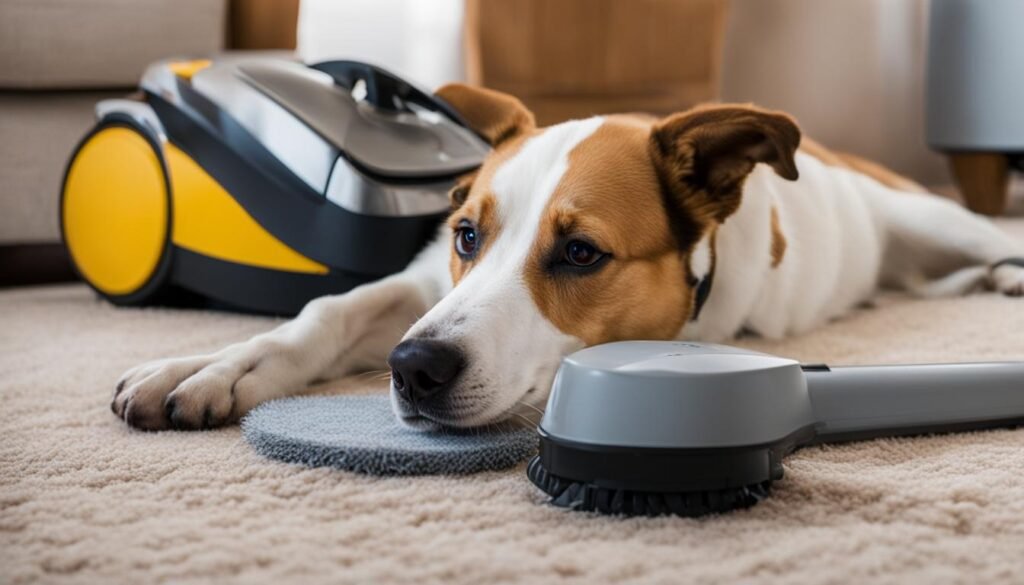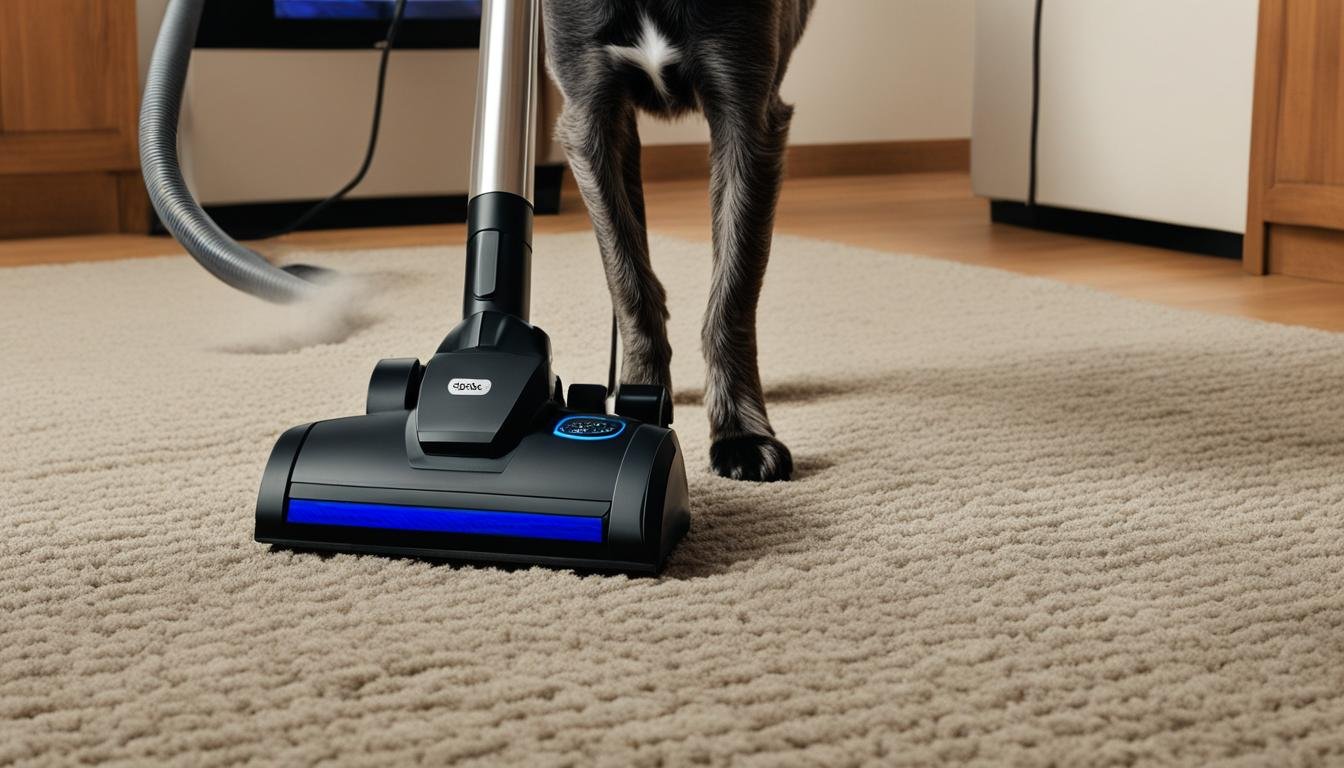Does your dog go into a frenzy every time you turn on the vacuum cleaner? The noise and movement of this common household appliance can trigger fear and anxiety in many dogs, leading to excessive barking and even aggressive behavior towards the vacuum.
So, how can you teach your dog to stay calm and quiet around the vacuum cleaner? In this article, I will share effective training techniques that can help you address your dog’s fear and put an end to the barking.
Key Takeaways:
- Systematic desensitization involves gradually exposing your dog to the vacuum cleaner and providing positive reinforcement to encourage calm behavior.
- Understanding why dogs fear the vacuum can help you tailor your training approach to address their specific anxieties.
- Desensitization and counter-conditioning are effective training techniques that can help dogs overcome their fear and anxiety towards the vacuum.
- Starting the training at an early age can prevent the development of fear and anxiety towards the vacuum cleaner.
- Seeking professional assistance can provide additional guidance and support throughout the training process.
Understanding Why Dogs Fear the Vacuum
When it comes to the vacuum cleaner, many dogs are plagued by fear and anxiety. Understanding the reasons behind their fear can help us address this issue and provide our furry friends with the support they need.
One of the primary factors contributing to a dog’s fear of the vacuum is the loud noise it produces. Vacuums emit a constant, often high-pitched sound that can be unsettling and bothersome to dogs, especially those who are sensitive to noise. This noise sensitivity can make the vacuum’s presence overwhelming and trigger a fear response in dogs.
Another aspect that contributes to their fear is the vacuum’s erratic movement. The swift and unpredictable movements of the vacuum cleaner may resemble prey or trigger a dog’s natural chase instinct. In some cases, this can lead to aggressive or reactive behavior, as dogs try to control or protect their environment from what they perceive as a potential threat.
It’s important to recognize that dogs may have different reasons for their fear of vacuums. Some dogs may have had a negative past experience with a vacuum cleaner that has left a lasting impression. Others may display herding instincts that activate when they see the vacuum moving around the house.
To help our furry friends overcome their fear of vacuums, it’s essential to address these underlying emotions and desensitize them to the vacuum cleaner. By gradually exposing them to the vacuum in a controlled and positive environment, we can help them become more comfortable and less reactive.
It’s important to approach the desensitization process with patience, consistency, and positive reinforcement. Helping our dogs associate the vacuum cleaner with positive experiences and rewarding them when they exhibit calm behavior can significantly contribute to their progress. By addressing both their sensitivity to noise and movement and understanding their unique behavior towards the vacuum, we can guide them towards a healthier, more relaxed relationship with this common household appliance.
Next, we’ll explore various training techniques that can be employed to help dogs overcome their fear of the vacuum cleaner.
Training Techniques to Help Dogs Overcome Fear of the Vacuum

To train dogs to be calm and comfortable around the vacuum cleaner, a method called desensitization and counter-conditioning can be used. This approach aims to gradually expose the dog to the vacuum cleaner in a controlled environment while providing positive reinforcement.
-
Introduce the vacuum from a distance: Start by placing the vacuum cleaner at a distance that doesn’t trigger fear or anxiety in the dog. Allow the dog to observe the vacuum without any forced interaction.
-
Pair the vacuum with positive experiences: Associate the presence of the vacuum with something enjoyable for the dog, such as giving treats or playing their favorite game. This helps create positive associations and reduces fear.
-
Gradually increase proximity: Over time, gradually move the vacuum closer to the dog while continuing to provide positive reinforcement. Monitor the dog’s reaction and progress at each stage.
-
Introduce movement and noise in small steps: Turn the vacuum cleaner on for short durations, starting with the lowest setting or without moving it to minimize fear. Gradually increase the movement and noise level as the dog becomes more comfortable.
-
Provide an escape route: Ensure that the dog has a clear pathway to retreat from the vacuum cleaner if needed. This gives them a sense of control and helps build confidence.
Starting the training at an early age, during the socialization period, is key to preventing the development of fear and anxiety towards the vacuum cleaner. Early exposure allows the dog to become familiar with the appliance and its noise and movement.
For more effective results, consider seeking the guidance of a professional dog trainer who specializes in desensitization techniques. They can provide expert knowledge, practical tips, and personalized training plans tailored to your dog’s specific needs.
Conclusion
Training a dog to overcome their fear of the vacuum cleaner and stop barking requires patience, consistency, and positive reinforcement. Using a systematic desensitization approach, we can gradually expose the dog to the presence, movement, and sound of the vacuum cleaner. This process helps the dog become desensitized, leading to a calm and relaxed behavior around the appliance.
Starting the training at an early age is beneficial, as it helps prevent the development of fear and anxiety towards the vacuum cleaner. Additionally, seeking professional assistance from a dog trainer who specializes in desensitization techniques can provide valuable guidance, ensuring the training is effective and tailored to the dog’s needs. With time and effort, dogs can overcome their fear, associate the vacuum cleaner with positive experiences, and become comfortable and quiet in its presence.
To stop dog barking at the vacuum cleaner, it’s important to remain consistent with the training process and provide positive reinforcement. By following these tips and techniques, dog owners can help their pets overcome their fear, creating a harmonious environment during cleaning sessions and ensuring a stress-free experience for both the dog and the owner.
FAQ
How can I stop my dog from barking at the vacuum cleaner?
To stop your dog from barking at the vacuum cleaner, you can use a training approach called “Systematic Desensitization.” This involves gradually exposing your dog to the vacuum cleaner and its sound, while providing positive reinforcement in the form of treats and praise. By desensitizing your dog to the vacuum cleaner and rewarding calm behavior, you can help them remain quiet and relaxed around the appliance.
Why do dogs fear the vacuum cleaner?
Dogs may fear the vacuum cleaner due to its loud noise and erratic movement. The noise emitted by vacuums can be unsettling and bothersome to dogs, especially those who are noise-sensitive. Additionally, the movement of the vacuum may trigger a chase or prey instinct in some dogs, leading to reactive or aggressive behavior towards the appliance.
What training techniques can help dogs overcome fear of the vacuum?
To help dogs overcome their fear of the vacuum cleaner, a method called desensitization and counter-conditioning can be used. This involves gradually introducing the vacuum to the dog in a controlled environment and pairing its presence with positive experiences such as treats and play. The process should be conducted at the dog’s pace, gradually increasing the proximity and intensity of the vacuum’s movement and sound. Seeking the guidance of a professional dog trainer who specializes in desensitization techniques can also be beneficial.
Can I train my dog to be calm around the vacuum cleaner?
Yes, you can train your dog to be calm around the vacuum cleaner. By following a systematic desensitization approach and gradually exposing your dog to the vacuum’s presence, movement, and sound, you can help them overcome their fear and develop a relaxed behavior. Starting the training at an early age and seeking professional assistance when needed can also contribute to the success of the training process.
What are some tips to stop dog barking at the vacuum cleaner?
Some tips to stop dog barking at the vacuum cleaner include using positive reinforcement, such as treats and praise, to reward calm behavior. Additionally, starting the training at an early age and gradually exposing your dog to the vacuum’s presence can help desensitize them to the appliance. Consistency, patience, and providing an escape route for your dog during the training process are also important factors in stopping dog barking at the vacuum cleaner.





Leave a Reply